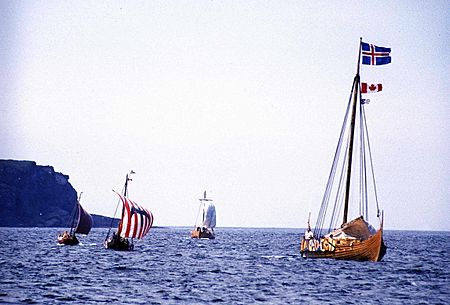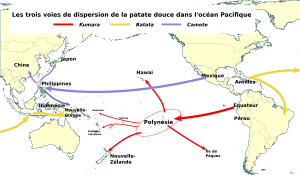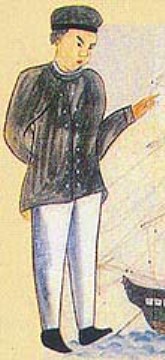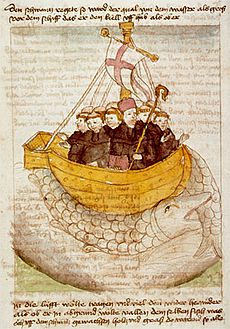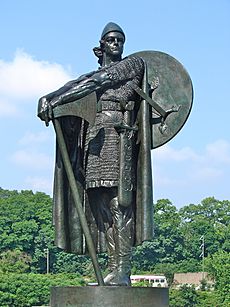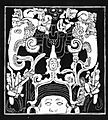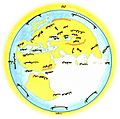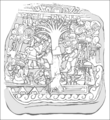Pre-Columbian transoceanic contact theories facts for kids
Pre-Columbian transoceanic contact theories are ideas about whether people from other parts of the world visited the Americas before Christopher Columbus' first trip in 1492. This means any visits that happened during the pre-Columbian era. Some theories also suggest that these visitors might have met and interacted with the indigenous peoples of the Americas.
Scientists have studied how the first humans came to the Americas. Some believe they traveled by boat along the Pacific coast. This might have happened at the same time as, or even before, people crossed the Beringia land bridge. This land bridge once connected what is now Siberia and Alaska.
Most scientists agree on only a few cases of contact before Columbus. For example, Norse people from Scandinavia explored the Atlantic Ocean. In the late 900s, they settled in Greenland. They also set up a camp at L'Anse-aux-Meadows in Newfoundland. This was about 500 years before Columbus arrived.
Recent studies also suggest that some people from eastern Polynesia might have mixed with people from the coast of South America. This contact might have happened around 1200 CE. Other claims of early contact are still debated. Many are based on clues that are not very clear. These include old artifacts, similar cultural ideas, or old stories. Some of these claims are seen as fringe science or pseudoarchaeology.
Contents
Norse Explorers in the Americas
There is strong proof that Norse people traveled to Greenland and Canada before Columbus. This proof comes from old writings and archaeological digs. A Norse colony was started in Greenland in the late 900s. It lasted until the mid-1400s.
In 1960, the remains of a Norse camp were found at L'Anse-aux-Meadows in Newfoundland, Canada. Scientists used radiocarbon dating to find out the camp was used between 990 and 1050 CE. More recently, tree-ring analysis showed that structures there were built in 1021.
L'Anse aux Meadows is the only place widely accepted as proof of contact before Columbus. UNESCO named it a World Heritage Site in 1978. It might be linked to Vinland, a settlement that Leif Erikson tried to start around the same time.
Few stories exist about Norse people meeting indigenous peoples. However, we know that the Norse in Greenland met the Thule people (ancestors of the modern Inuit). This happened in the 1100s or 1200s. The Norse called these new settlers "skrælingar". Old Norse writings mention fights between the Greenlanders and the "skrælings".
Polynesian and Austronesian Contact
Genetic Clues from DNA
Between 2007 and 2009, scientists found clues in DNA that suggest people from the Americas mixed with people on Easter Island. This likely happened before Europeans arrived on the island. In 2014, another study found more genetic proof of contact between Easter Island and South America. This contact was dated to about 600 years ago, around 1400 CE.
A 2013 study looked at the remains of "Botocudo" people from Brazil. Two of these remains had a type of DNA (mtDNA haplogroup B4a1a1) usually found only in Polynesians. The scientists thought it was very unlikely for Polynesians to have traveled directly to Brazil. They also thought it was unlikely that this DNA came from the African slave trade.
In 2020, a study in Nature found that people on Mangareva, Marquesas, and Palliser islands, and Easter Island, had DNA from South American native groups. The DNA matched most closely with Zenú people from Colombia. This suggests a single ancient contact event. It might have happened in eastern Polynesia between 1150 and 1230 CE. Or, Polynesians might have sailed to South America and returned with South American people or their genes.
The Sweet Potato Story
The sweet potato is a food crop that originally came from the Americas. But it was already common in Polynesia when European explorers first arrived. Sweet potatoes found in the Cook Islands have been dated to 1000 CE. Scientists now think it was brought to central Polynesia around 700 CE and spread from there.
How did it get there? Some think Polynesians traveled to South America and brought it back. Others suggest South Americans brought it to Polynesia. It's also possible the plant floated across the ocean. Studies of sweet potato DNA support the idea that it was brought from South America to Polynesia at least twice. One time was before Europeans arrived.
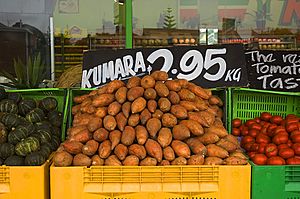
Experts in languages have noticed that the word for sweet potato is similar in Polynesian languages and some South American languages. For example, the Polynesian word kumala (like kumara in Māori) is similar to k'umar in Quechua and Aymara. This similarity strongly suggests that people from the Andes region and the South Pacific had some contact. However, it doesn't necessarily mean large groups of people migrated.
Disputed Evidence: Araucanian Chickens
In 2007, some evidence suggested that the Mapuche people of Chile might have had contact with Polynesians before Columbus. Bones of Araucana chickens found in Chile were dated to between 1304 and 1424. This was before the Spanish arrived. The chicken DNA matched chickens from American Samoa and Tonga, but not European chickens.
However, other studies in 2008 and 2014 questioned these findings. They suggested the DNA results might have been wrong due to contamination. But in 2013, the original researchers continued their work. They concluded that their findings still supported the idea of Polynesian contact with the Americas. A 2019 study also found a unique genetic link between Easter Island chickens and some South American chickens. This might suggest a common origin.
Disputed Evidence: California Canoes
Some researchers think there might have been contact between Hawaiians and the Chumash people of Southern California between 400 and 800 CE. The Chumash and Tongva people built unique sewn-plank canoes. These canoes are similar to larger ones used by Polynesians for ocean travel. The Chumash word for their canoe, tomolo'o, might come from the Hawaiian word tumula'au.
Most archaeologists who study these cultures do not agree with this theory. They believe the Chumash canoes developed on their own over many centuries.
Claims of East Asian Contact
Claims of Chinese Contact
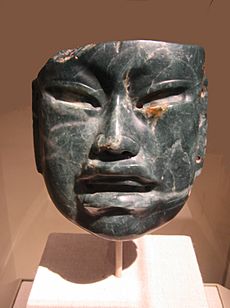
Some researchers have suggested that the Olmec civilization in Mexico might have been influenced by Chinese refugees. This idea came from similarities seen in Olmec art and tools to those from Bronze Age China. However, most experts on Mesoamerican history do not support these claims.
Other stories talk about early Chinese contact with North America. In 1882, about 30 brass coins were found in British Columbia, Canada. They were found deep underground in an area where Chinese gold miners worked. Some thought these coins were very old, but a museum curator identified them as good luck tokens from the 1800s.
A group of Chinese Buddhist missionaries, led by Hui Shen, claimed to have visited a place called Fusang before 500 CE. While Chinese maps put Fusang on the Asian coast, some people have suggested it might have been in North America.
A British author, Gavin Menzies, claimed in his book 1421 that Chinese admiral Zheng He's fleets reached America in 1421. However, professional historians say there is no proof for this claim. Zheng He's voyages are known to have reached the eastern coast of Africa.
Doughnut-shaped stones found off the coast of California were once thought to be ancient Chinese anchors. This would have been proof of Chinese sailors visiting long ago. But later studies showed they were made of local rock. They were likely used by Chinese fishermen in the 1800s.
Claims of Japanese Contact
Some archaeologists suggested that pottery from the Valdivia culture in Ecuador (3000–1500 BCE) looked similar to pottery from the Jōmon period in Japan. They thought this might mean the two cultures had contact. But most archaeologists think this idea is unlikely. The similarities might just be because there are only so many ways to decorate clay.
An anthropologist named Nancy Yaw Davis believes the Zuni people of New Mexico have language and cultural similarities to the Japanese. She suggests that Japanese Buddhist priests or peasants might have crossed the Pacific in the 1200s. They could have traveled to the American Southwest and influenced Zuni society.
In the 1890s, James Wickersham argued that Japanese sailors likely reached North America before Columbus. He noted that many Japanese ships were carried by ocean currents to North America between the 1600s and 1800s. These ships landed from the Aleutian Islands to Mexico. Wickersham thought it was unlikely that such contacts only started after Europeans arrived.
Claims of African Contact
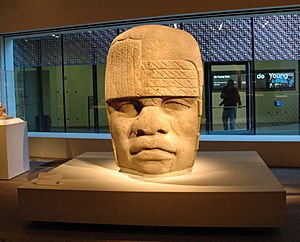
Some theories suggest that Africans might have visited Mesoamerica. These ideas come from features of the Olmec culture, claims of African plants in the Americas, and old European and Arabic stories.
The Olmec culture was in southern Mexico from about 1200 BCE to 400 BCE. Some people, like Ivan Van Sertima, have suggested that Africans influenced the Olmecs. Van Sertima claimed that ideas like Mesoamerican pyramids, calendar technology, and mummification came from Africans who sailed to the Americas. He also suggested that the Aztec god Quetzalcoatl might have been an African visitor. However, most experts strongly criticize these claims and call them pseudoarchaeology.
Old North African writings describe a fleet from the Mali Empire that supposedly visited the New World in 1311. This fleet was led by Abu Bakr II. Also, Christopher Columbus's journal mentions that King John II of Portugal heard about canoes from West Africa sailing west with goods. Columbus also heard from people in Hispaniola that "black people" had come from the south. These people had spear tips made of a metal called guanin, which was a mix of gold, silver, and copper.
Claims of European Contact
Norse, Irish, and Welsh Legends
The legend of Saint Brendan, an Irish monk, tells of a fantastic journey across the Atlantic in the 500s. He was searching for Paradise. Since the Americas were discovered, some authors have tried to link Brendan's legend to an early discovery of America. In 1977, Tim Severin successfully sailed a replica of an ancient Irish boat, showing such a trip was possible.
A British myth says that Madoc was a prince from Wales who explored the Americas around 1170. Most scholars believe this legend is not true. However, it was used in the past to support British claims to land in the Americas. Later versions of the story claimed that Madoc's travelers married Native Americans. They said their Welsh-speaking descendants still lived in the United States. No clear archaeological proof of Madoc's voyages has been found.
Claims of Travel from the New World to the Old World
Egyptian Coca and Tobacco
Scientists have found traces of coca and nicotine in some ancient Egyptian mummies. Coca is from the Americas, and tobacco is mostly from the Americas. This led to ideas that ancient Egyptians might have had contact with the New World. The first discovery was made by a toxicologist, Svetlana Balabanova. She found these substances in the mummy of a priestess named Henut Taui.
Other tests on Sudanese mummies also showed similar results. Balabanova suggested that tobacco might have grown in China and Europe long ago, but has since died out. Some people think the findings might be due to fraud or contamination. However, other researchers have also found nicotine in mummy samples.
A re-examination of the mummy of Ramesses II in the 1970s found tobacco leaves. This became a popular topic for those who believed in early contact. But some experts pointed out that the mummy had been moved many times. This means the tobacco could have gotten into the mummy's open abdomen much later.
Icelander DNA Clues
In 2010, a genetic study showed that over 350 people living in Iceland had a type of DNA (C1e) that was previously only found in Native American and East Asian groups. This DNA entered the Icelandic population by 1700, possibly much earlier. While a Native American origin seems most likely, an Asian or European origin cannot be completely ruled out.
A 2014 study found a similar type of DNA (C1f) in ancient remains in Russia. This led to a new idea: both C1e and C1f might have come from a common ancestor in northern Europe. Vikings, who settled Iceland, raided western Russia. So, both types of DNA might have been brought to Iceland by Vikings.
Norse Legends and Sagas
Old Norse legends tell that in 1009, the explorer Thorfinn Karlsefni took two children from Markland (a part of North America). The children were taken to Greenland, where they learned Norse.
In the 1400s, a Danish geographer wrote that he saw "pygmies" from Greenland who were caught by Norsemen. Their small skin boats were hung in a cathedral. This description fits the Inuit people and their kayak and umiak boats.
Ferdinand Columbus wrote that his father, Christopher Columbus, saw two dead bodies in a boat in Ireland in 1477. The bodies and boat looked unusual. Some think they might have been Inuit who drifted off course.
Claims Based on Religious Stories
Christian Missionary Claims
During the time Spain colonized the Americas, some Spanish writers thought that Christian preachers might have visited Mesoamerica long before Columbus. For example, Bernal Díaz del Castillo was curious about cross symbols in Mayan writings. He thought they might mean other Christians had arrived earlier.
Fray Diego Durán linked the legend of the Pre-Columbian god Quetzalcoatl to Christian apostles. He described Quetzalcoatl as pure, regretful, and a miracle-worker. Other writers described Quetzalcoatl as fair-skinned, tall, and bearded, suggesting he might have come from the Old World. However, modern scholars doubt these claims. Agriculture was practiced in the Americas long before Christianity, and Mayan crosses had different meanings.
According to an old myth, Quetzalcoatl left Mexico by traveling east across the ocean, promising to return. Some scholars thought that Aztec emperor Moctezuma Xocoyotzin believed the Spanish conquistador Hernán Cortés was Quetzalcoatl returning. However, others disagree with this idea.
Knights Templar Claims
A fringe theory suggests that a fleet of Knights Templar might have sailed to the Americas in 1307. They were fleeing persecution in France. It's thought they might have met native people there. This hypothetical visit is sometimes linked to cross symbols in Mesoamerican cultures or legends about a fair-skinned god. However, experts doubt this voyage happened, as the Knights Templar likely didn't have ships for such a long Atlantic journey.
Ancient Jewish Migration Claims
For centuries, some European thinkers tried to explain the presence of Native Americans by linking them to the Ten Lost Tribes of Israel. These tribes were supposedly deported after their kingdom was conquered. These ideas were used by religious groups to support their beliefs and even to justify European settlement in the Americas.
One of the first to claim this was a Portuguese rabbi, Menasseh Ben Israel. He wrote that finding these "lost Jews" meant the Biblical Messiah was coming soon. In 1650, a preacher named Thomas Thorowgood wrote a book arguing that Native Americans were descendants of the Ten Lost Tribes.
Latter Day Saint Teachings
The Book of Mormon, a sacred text for the Latter Day Saint movement, states that some ancient people in the New World came from Semitic groups who sailed from the Old World. Groups like the Foundation for Ancient Research and Mormon Studies try to study these ideas.
However, the National Geographic Society stated in 1998 that archaeologists have not found anything to support the Book of Mormon's claims. Some scholars within the Latter Day Saint movement also acknowledge that the Book of Mormon's stories might not perfectly match modern archaeological findings.
See also
 In Spanish: Contactos transoceánicos precolombinos para niños
In Spanish: Contactos transoceánicos precolombinos para niños
Images for kids
-
Anne Stine Ingstad examining a fire pit at L'Anse-aux-Meadows in 1963.
-
Mocha Island off the coast of Chile.
-
'Elye'wun, a reconstructed Chumash tomol.
-
A jade Olmec mask. Some thought the Olmec art style might have come from Bronze Age China.
-
Al-Mas'udi's map includes a continent west of the Old World.
-
A Roman mosaic depicting a fruit that looks like a pineapple.


